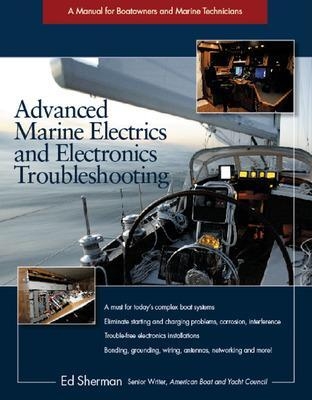
Advanced Marine Electrics and Electronics Troubleshooting
International Marine Publishing Co (Verlag)
978-0-07-146186-3 (ISBN)
- Titel ist leider vergriffen;
keine Neuauflage - Artikel merken
SAVE TIME AND MONEY WITH THIS STATE-OF-THE-ART GUIDE TO THE LATEST, MOST ADVANCED DIAGNOSTIC EQUIPMENT AND TECHNIQUES“Ed Sherman is one of America’s great teachers and communicators of marine technology.”--Tim Murphy, Executive Editor, Cruising WorldWhether you are a marine electronics professional or a boatowner, Advanced Marine Electrics and Electronics Troubleshooting helps you understand the new, more powerful methods of troubleshooting marine electrical and electronic systems. A modern boat’s sophisticated installations and networked electronics can stretch the traditional diagnostic methods based on trouble lights and multimeters past their useful limits. This book will show you how to:
Use microprocessor-based diagnostic tools and techniques from the automotive and communications sectors, adapted for boats for the first timeDiagnose the most difficult AC and DC problemsProtect communications and navigation electronics from interference and lightningSeek out and eliminate stray-current sources and galvanic corrosion
Ed Sherman is a well-known boating writer and educator, and the author of two International Marine books: Outboard Engines (1997) and Powerboater's Guide to Electrical Systems (2000). He is the assistant director of education at the American Boat and Yacht Council (ABYC), the country's preeminent standard-making body, where he designs and teaches teacher-training programs in marine technology fields, including marine electrical systems. Prior to that, he taught marine electronics for many years at the New England Institute of Technology, in Warwick, RI, where he was chairman of the marine technology department. Hometown: Wickford, RI
Foreword by Tim Murphy, Executive Editor, Cruising WorldPrefaceAcknowledgments1. Marine Troubleshooting the Modern WayFinding Your WayElectrics versus ElectronicsBasic Troubleshooting StepsPart 1: Electrical Systems Troubleshooting2. Testing Batteries, Charging Systems, and Starter Circuits, and Measuring Voltage DropCatalysts for ChangeConductance Battery TesterDiagnostic MeterValue and Utility3. Testing Continuity and Tracing CircuitsTone-Generating Circuit TracerAlphanumeric Time Domain ReflectometerValue and Utility4. Testing AC and Grounding Systems for Polarity, Voltage Drop, Impedance, and FrequencyThe SureTest Circuit AnalyzerValue and Utility5. Temperature Monitoring as a Diagnostic AidInfrared Heat-Sensing GunOther Uses for Temperature MonitoringValue and Utility6. Using Power Factor to Determine Energy EfficiencyUnderstanding Power FactorImproving Your Power FactorDetermining Power ConsumptionUsing a Power AnalyzerValue and Utility7. Analyzing Harmonic DistortionDo You Need a Scope?AC LoadsHarmonic DistortionValue and Utility8. Using a Laptop for Intermittent ProblemsLaptop Link-UpsReal-World Examples9. Testing for Electromagnetic and Radio Frequency InterferenceUnderstanding Electromagnetic InterferenceStandards and RegulationsCommon Sources and Victims of InterferenceTools of the Trade10. Testing for Residual Current and Isolating Its SourcesAC Leakage from AppliancesUsing a Clamp-On AC Leak TesterAC Leakage from Degraded InsulationUsing a MegohmmeterValue and Utility11. A Basic Corrosion SurveyTools of the TradeUnderwater Metal Corrosion and Protection BasicsConducting a Corrosion Survey12. Grounding SystemsLightning ProtectionGrounding to Minimize RFI EffectsComparing ABYC and NMEA Grounding StandardsTroubleshooting ReduxPart 2: Marine Electronics Installation and Troubleshooting13. Electronic Equipment Installation GuidelinesErgonomicsWatertight IntegrityThermal LimitsPower SupplyGuidelines Summary14. Installing Communications and Position-Finding Systems and RadarCommunications SystemsPosition-Finding SystemsRadar15. Installing Depth Sounders, Weather Systems, and AutopilotsDepth SoundersWind- and Weather-Monitoring InstrumentsAutopilots16. Coaxial Cable and AntennasCoaxial Cable BasicsChoosing Coax for Marine ApplicationsInstalling Coaxial CableVHF AntennasSSB AntennasSatellite Television and Radio AntennasCell Phone AntennasRadar Antennas17. Onboard NetworksNetwork TypesNMEA 2000TroubleshootingThe Future of Onboard Power DistributionClosing Thoughts
Appendix A: Metric EquivalentsAppendix B: ResourcesAppendix C: ABYC Standards of Interest to Marine Electricians and BoatownersGlossaryList of AcronymsIndex
| Erscheint lt. Verlag | 16.6.2007 |
|---|---|
| Zusatzinfo | 25 Illustrations |
| Verlagsort | Rockport, ME |
| Sprache | englisch |
| Maße | 191 x 234 mm |
| Gewicht | 670 g |
| Themenwelt | Sachbuch/Ratgeber ► Sport ► Segeln / Tauchen / Wassersport |
| Technik ► Fahrzeugbau / Schiffbau | |
| ISBN-10 | 0-07-146186-8 / 0071461868 |
| ISBN-13 | 978-0-07-146186-3 / 9780071461863 |
| Zustand | Neuware |
| Haben Sie eine Frage zum Produkt? |
aus dem Bereich


